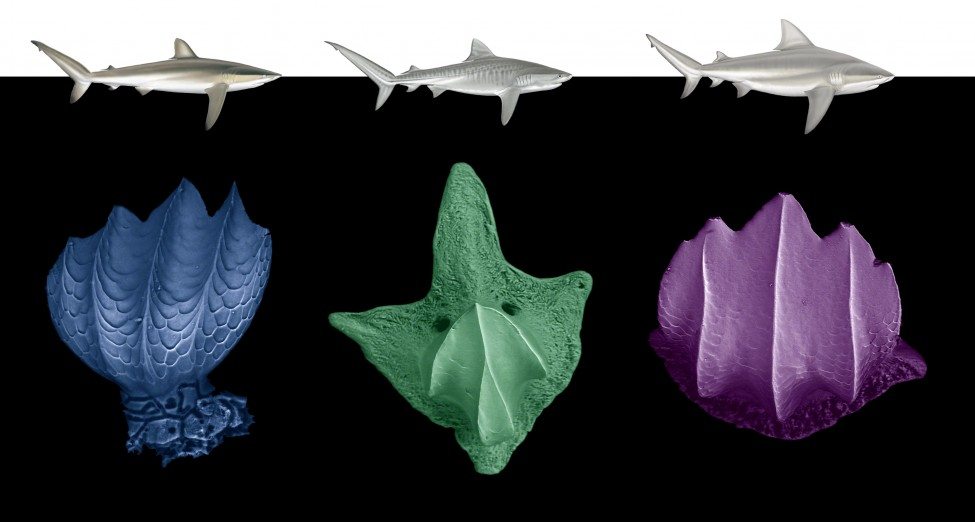In conversation with Erin Dillon
As part of a project called Baseline Caribbean, Erin Dillon is pioneering a new method of shark palaeontology that uses fossilised scales (dermal denticles) to discover what pristine shark communities looked like in Bocas del Toro, Panama. Philippa Ehrlich spoke to her about her study.
Photo by Sean Mattson
Erin Dillon is pioneering a new method of shark palaeontology that uses fossilised scales (dermal denticles) to discover what pristine shark communities looked like in Bocas del Toro, Panama.
How did you become a shark palaeo-ecologist?
I attended a talk by Loren McClenachan in 2013. She was presenting her research on historical ecology, which involves looking at shifting baselines and analysing photos to investigate how the sizes of fish had changed over time. It was a really neat study and was probably my first introduction to historical ecology. It got me thinking about different tools that people can use to look at change over time in ecosystems, both in terms of community ecology and how people are influencing them. Then I got the opportunity to come down to Panama to work at the Smithsonian Tropical Research Institute (STRI) as an intern in Aaron O’Dea’s lab. He does a lot of research in palaeo-ecology and was working on this Baseline Caribbean project, which is essentially trying to reconstruct entire reef communities using time points from about 7,000 years ago, before major exploitation by humans. Aaron and his collaborators hadn’t really started looking at denticles yet. They’d found them in a couple of sediment cores, but they were very rare, so the team hadn’t begun to investigate them further. This gave me an opportunity to explore the denticle question a bit more and start to look at how shark communities were changing over time.
Why is Bocas del Toro such an appropriate study site?
Bocas is a neat site because there is an exposed, really rare and beautifully preserved mid-Holocene reef that dates back about 7,000 years. It gives us a window into the past, into what ‘pristine’, pre-fishing, pre-exploitation communities may have looked like. You can walk through the different reef zones. You can see where there might have been sea grass in one area and how there was a lot of staghorn coral on the reef itself. This species of coral is now listed as Critically Endangered on the IUCN Red List of Threatened SpeciesTM. The region has also been well studied by scientists at STRI, and there are modern reefs neighbouring the fossil reefs, all within the same sheltered fringing reef environment.
Can you walk me through your method?
We collect large bags of reef sediments from the fossil site and then do the same on the nearby modern reefs using scuba. All this carbonate material gets digested down using acetic acid, leaving us with things such as fish ear bones (otoliths), fish teeth, the spiny skeletal parts of sponges (spicules) and shark denticles. These are picked out of the samples manually using a paintbrush. We then compare the fossils with the modern samples to look at change over time in a similar environment. Historical reefs are usually covered up by modern reefs or mangroves, so this exposed site presents us with a unique opportunity to use palaeontology to look at the past in Bocas del Toro.
So what was Bocas del Toro like 7,000 years ago?
About 7,000 years ago it looked like there were a lot more corals, especially staghorn coral Acropora cervicornis and branching finger corals Porites spp. There’s been an unprecedented shift to lettuce coral Agaricia tenuifolia within the past century. But a coral reef is much more than just the coral. Our lab is focused on reconstructing the whole reef community. All the data are getting worked up right now. We’re looking at fish ear bones and teeth, we’re looking at dermal denticles and we’re looking at sponge spicules, for example, but the picture is still pretty preliminary in terms of piecing together the entire community. In terms of relative abundance, it appears that there are fewer fish and fewer sharks today, but also that the communities have shifted. We’re still trying to work out exactly how those shifts occurred.
Shark skin time travel
Erin uses fossilised shark scales to go back in time to the world of sharks before humans, giving us our first real glimpse of what pristine shark abundance might have looked like.


